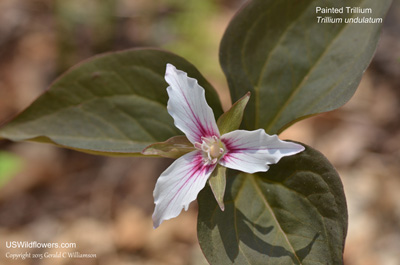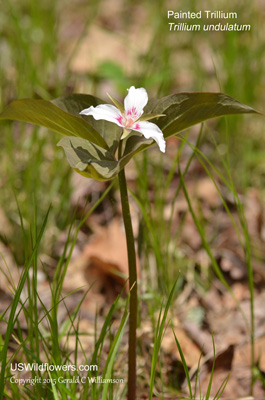Painted Trillium, Painted Wakerobin, Painted Lady - Trillium undulatum
|
Trillium undulatum - Painted Trillium, Painted Wakerobin, Painted Lady. Trillium was formerly classified in Liliaceae, but most authorities have placed it in Melanthiaceae, because unlike other Liliaceae, the petals and sepals of Trillium are distinctly different. A number of respected authorities now place Trillium in Trilliaceae. I'm hanging on to Liliaceae until the dust settles.
Trillium undulatum is one of the pedicellate Trilliums, frequently referred to as Wakerobins; this species is also known as Painted Wakerobin. It's mostly a species of the northeastern United States and eastern Canada, with some populations as far west as small parts of Ohio and Michigan. It's found in the Appalachian mountains in southern Pennsylvania thru the Virginias and south as far as northern Georgia and northern South Carolina. It is classified as Threatened, Endangered, or Vulnerable in Kentucky, Michigan, New York, and Ohio. It grows in acidic forests, usually in deeply shaded areas except in the higher elevations.
It is reported that the berries and roots have low levels of toxicity if eaten. It blooms in late spring and early summer.
Found in:
CT, GA, KY, MA, MD, ME, MI, NC, NH, NJ, NY, OH, PA, RI, SC, TN, VA, VT, WV, GS
Leave comments on Trillium undulatum at this link. | 
Distribution of Trillium undulatum in the United States and Canada:

Blue=Native; Grey=Introduced
Map from USDA Plants Database:
USDA, NRCS. 2017. The PLANTS Database (http://plants.usda.gov, 16 Jan 2025). National Plant Data Team, Greensboro, NC 27401-4901 USA.
Search Our Database: Enter any portion of the Scientific, Common Name, or both.
Do a general Google search of the entire site:
#ad
 Follow USWildflowers on Twitter
| | Site: GSMNP, Swain County, NC Date: 2015-May-05 | Photographer: Gerald C. Williamson
Nikon D7000
Tamron SP 90MM f/2.8 AF Macro | | The lovely flower of Trillium undulatum rises above 3 blue-green, prominently-veined bracts - which are considered leaves by most of us. The leaves and sepals usually have a maroon hue under the green; occasionally the sepals are wine red. | | 
| | Site: GSMNP, Swain County, NC Date: 2015-May-05 | Photographer: Gerald C Williamson
Nikon D7000 | | The edges of the petals of Trillium undulatum provide the species epithet - they are undulate (wavy.) Without the characteristic coloration - an inverted V of red radiating along the veins - the flower of this plant could easily be mistaken for that of Trillium grandiflorum - Large-flowered Trillium. However, the anthers of T. undulatum are white or pink, whereas they are yellow in T. grandiflorum. The ovary is usually relatively larger than that of T. grandiflorum. It is 3-angled, and usually pink-tinged white. It is reported that there is a form of Painted Trillium without that distinguishing red mark; in addition to other floral characteristics described above, the bract/leaf color can be used to distinguish this species. There is also a form of T. undulatum with green rather than white petals. | | Click on the photo for a larger image

| | Site: GSMNP, Swain County, NC Date: 2015-May-05 | Photographer: Gerald C Williamson
Nikon D7000 | | This beautiful woodland Trillium rises on a stem that is 8 to 16 inches tall. The leaves (bracts) are on petioles and the flower is on an arching pedicel. It grows usually in deep woods, but at higher elevations, as here at more than 5,000 feet, it grows in more open woods. | | Click on the photo for a larger image

|
References used for identification and information:
|
|
| |
| #ad
|
|





